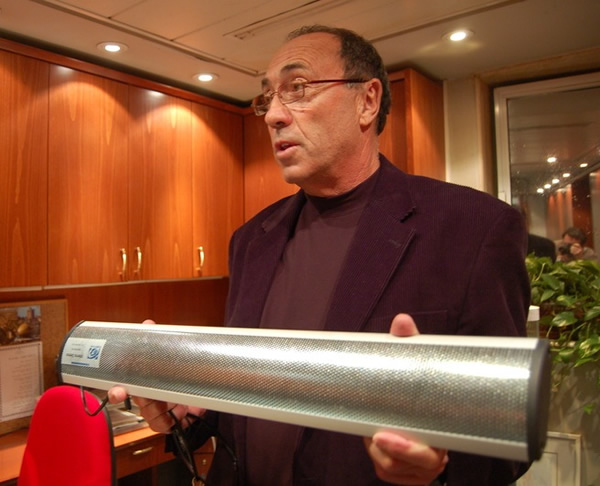Inferno, otra arma sónica para la colección
By Chiu Longina • Apr 3rd, 2008 • Category: DISPOSITIVOS
http://www.inferno.se/
Press Articles about this device
DOWNLOAD INSTALL GUIDE FOR INFERNO
Literal: (from Wired Blog)
I Was a Sonic Blaster Guinea Pig
By Sharon Weinberger, February 13, 2008Last week, I was sitting in a hotel bar in Jerusalem when a fellow passenger on my tour told me there was a guy with us selling a supposedly less-lethal weapon.
“It works with sound frequencies,” he said. “It’ll make you a sick.”
A puke ray? An honest-to-God puke ray? Right here in Jerusalem?
Well, more like a sonic blaster. Dr. Maurice Goldman, a retired dentist, is the U.S. managing director for Inferno, a line of products that markets itself as a “sound barrier.” The primary effect of the device, which sounds like a loud siren, is to force people to leave the protected area, he says. However, if the intruder doesn’t leave immediately, Inferno’s effects include “vertigo, nausea, and pain in the chest.”
The unit is made in Sweden, but Dr. Goldman has already sold a couple units to U.S. Special Operations Command, and he’s hoping soon to close a contract with the U.S. State Department, which would use the device in embassies. He also offered to let me try it out.
My old rule was: never volunteer to to be a test subject for a less-lethal weapon (or a lethal one for that matter). Life is short enough as it is, and my hearing and vision are important to me. But since breaking that rule over the summer with the “pain ray,” the Pentagon’s Active Denial System, I thought, well, why not?
Two days later, we sat in a hotel office, with Dr. Goldman (pictured above), holding the device. The version of Inferno he was demonstrating looked a bit like a long, slim speaker. You can’t take a pair of nail scissors on a plane these days, but Dr. Goldman has traveled around the world with Inferno and has had few, if any problems, boarding aircraft.
First, I dispatched Nathan, my husband, out of the room, using the logic that if it really did make us sick, one of us should be spared. Then I realized I needed pictures, so I called him back in, and without warning, Goldman turned the Inferno on. I’m not sure words can do justice to what can only be described as the most unbearable, gut-wrenching noise I’ve ever heard in my life. I screamed a few expletives, Nathan almost dropped the camera, and Dr. Goldman turned it off.
Here’s how it works: Inferno uses four frequencies spread out over 2 to 5 kHz. The idea behind it is that unlike a regular siren, these particular frequencies have a uniquely disturbing effect on people (and presumably cats, dogs and any other living thing). At 123 dB, it’s loud, but not significantly louder than any other alarm system. The advantage, according to Dr. Goldman, is the combination of frequencies. The human ear just doesn’t like it. I agree, I really didn’t like it.
How did I feel after the impromptu test? Nauseous, dizzy, or in pain? Hard to say, but Nathan looked pretty unhappy with me for the next hour or so. In fact, he still grumbles a bit when I mention his unwitting recruitment as a camera man/guinea pig. Love hurts.
Summary verdict: Being a guinea pig for a sonic ray was truly a whole lot worse than being a guinea pig for the pain ray. I would happily volunteer again to be hit by the Pentagon’s pain ray. It was fun, like being Bugs Bunny dancing around when Elmer Fudd tries to shoot him. I never, ever again want to be hit by the Inferno.
But here’s the question: what does a really unbearable sound do to a person? The Active Denial System appears to effectively prompt people to get out of its way. The Long Range Acoustic Device, a hailer, was famously used to thwart a pirate attack. But there is considerable debate over whether LRAD, when used as something other than as a warning device, is more effective than any other loud speaker.
In other words, will the Inferno work better than just a loud noise? For example, when I’ve accidentally set off my ADT alarm at home, it’s pretty damn annoying, and according to web references, it’s 120 dB. Inferno counts on the unique frequency spread to make it work better, but what does better mean? Does that mean a criminal/terrorist/insurgent will stop what they’re doing?
The trick with acoustic weapons is demonstrating that there is a unique, deterrent effect on humans. Penn State’s Applied Research Laboratory, as we’ve written here earlier, is planning to test at ranges of about 130 dB to see if sound can have a deterrent effect. It would be interesting, in my view, to test whether louder is better, or whether, as Dr. Goldman says, that the frequency combination is better. The problem in all these areas is the lack of test data. Dr. Goldman notes that the only human tests on Inferno were done informally with workers in South Africa (the workers, who were promised money for sitting through an Inferno blast, didn’t last more than a few seconds, he says).
Will Inferno be the next sonic blaster? Dr. Goldman knows it’s an uphill battle to break into the security market, but he’s confident that Inferno could be used for everything from alarms systems and prison riot control, to law enforcement and personal protection. Other applications, like maritime self-defense, are also possible. “Right now, I’m having fun,” he says.
Update:
In answer to a few of the comments below, yes, earplugs, or any other hearing protection device would mitigate the effects of Inferno. In my case, just covering my years with my hands helped a lot.
Via: http://blog.wired.com/defense/2008/02/i-was-a-puke-ra.html

Chiu Longina is
Email this author | All posts by Chiu Longina




